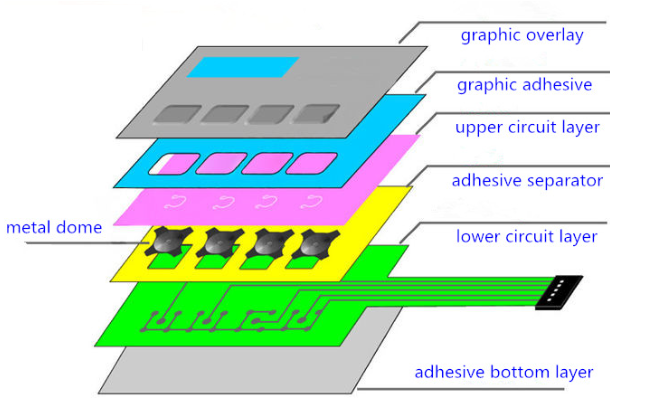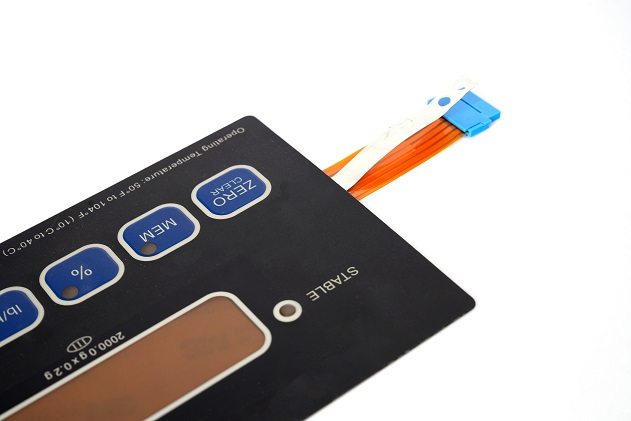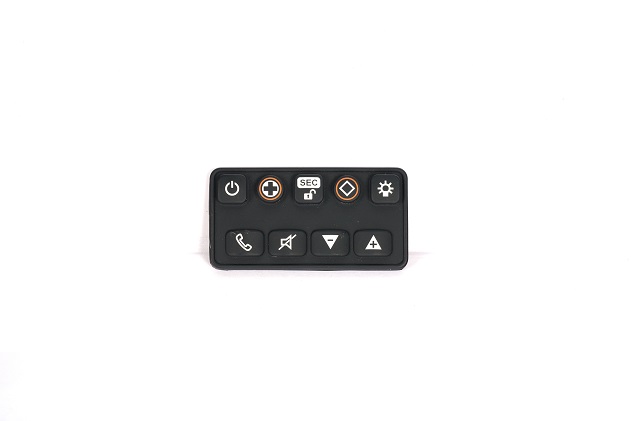What is a membrane switch?
A membrane switch, also known as a tactile keyboard, is a new type of electronic component that integrates light, mechanics, and electricity into a sealed, multilayered structure. It combines key switches, panels, markings, symbol displays, and backing plates into a single sealed unit. This innovation represents a fundamental change in the external structure of electronic products, replacing conventional discrete components to execute tasks in operating systems more reliably.
A membrane switch is composed of four parts: the panel, upper circuit, isolation layer, and lower circuit. When the switch is pressed, the contact of the upper circuit deforms downward, touching the lower circuit to create a connection. Once the finger is released, the contact rebounds, breaking the circuit and triggering a signal.

The membrane switch has a rigorous structure, beautiful appearance, and good sealing performance. It has the characteristics of good waterproof, dustproof, oil proof, harmful gas erosion proof, and long service life. The main type of membrane switch is the membrane switch panel, which is an electronic component composed of a rigid or flexible printed circuit board as the substrate, with tactile or non tactile buttons installed, and then covered with plastic (polycarbonate PC, polyester PET, etc.) film panels printed with colored decorative patterns. It integrates switch function and decorative function, and is a new type of human-machine dialogue interface. The connection between its switch circuit and the entire machine can be achieved through welding or plugging.
Types of membrane switch
1. Flexible membrane switch
This is the most common type of membrane switch, referred to as flexible due to its construction from flexible materials for the panel, isolation layer, and circuit layer. The circuit layer, typically made from PET (polyester) with good electrical properties, contains the switching circuit patterns and tactile domes. Due to the properties of polyester, flexible membrane switches have good insulation, heat resistance, flexibility, and resilience. The circuit patterns, including connections and lead wires, are printed with conductive inks cured at low temperatures.

2. Rigid membrane switch
Rigid membrane switches have their circuits and patterns created on rigid printed circuit boards (PCBs). These switches are easy to manufacture, have stable processes, and low resistance. Certain components can be directly soldered onto the back of the rigid PCB, eliminating the need for an additional backing layer. Rigid switches often use metal domes for tactile feedback, providing a good tactile feel. However, they are less convenient to integrate into equipment compared to flexible switches, usually requiring soldering and flat cables for connections.

3. Flat membrane switch
In the early stages of membrane switches, key positions, shapes, and sizes were indicated solely by color differences, leading to reliance on visual identification for operation accuracy.
4. Embossed membrane switch
Membrane switches with embossed keys, which are raised above the panel to form a 3D shape, improve identification speed and tactile sensitivity, enhancing both functionality and aesthetic appeal. The embossing is generally done using precise molds.
Metal domes in Membrane switch
Metal domes, also known as snap domes, are a key component of membrane switches, usually made of ultra-thin (0.05mm-0.1mm thickness) and ultra thick (generally high hardness) stainless steel 301 or 304 materials. These domes provide a good tactile feel and precise travel control. They are used in membrane switches, contact switches, PCBs, FPCs, medical devices, and more. In addition to metal domes, other types such as thermoformed tactile domes and flat tactile domes are available, each with its own set of advantages and applications.
- Metal Domes (Snap Domes)
Metal domes are used as the conductive medium in membrane switches, offering advantages such as a good tactile feel, consistent actuation force, and precise travel accuracy. They have a wide operating temperature range, typically from -20┬░C to 80┬░C. However, if the backing plate is not flat or if it is attached to a surface with excessive curvature, it may cause short circuits, malfunctions, or lack of rebound.
- Embossed Tactile Domes
These domes create rebound force through embossed points formed after printing the contact surface on the membrane material. This type of dome has a long lifespan, reaching up to 500,000 cycles, and provides a good tactile feel. The travel distance and force can be customized according to customer needs. However, the mold cost is high, requiring specific embossing molds, and using these domes in high-temperature environments may weaken the actuation force.
- Flat Tactile Domes
These domes use a membrane substrate printed with a conductive material at the contact points, without any secondary processing. The keys have a high lifespan, reaching up to 1 million cycles, and offer a large contact area, ensuring good conductivity. However, they lack tactile feedback, which can lead to repeated or incorrect operations.
Additionally, there are Capacitive Sensing Domes and EL (Electroluminescent) Backlit Domes. Capacitive sensing domes use conductive materials to sense touch and can operate from a certain distance, but their production yield is low, and they are sensitive to surrounding electromagnetic interference. EL backlit domes, in contrast to LED light guide types, significantly reduce thickness, making them suitable for always-on states without heat concerns.
What is the difference between a tactile switch and a membrane switch?
1. Working principle
Tactile switches usually achieve switch functions through touch sensing, without the need for physical contact, but by sensing the proximity or touch of fingers or other objects to trigger changes in switch status. This type of switch typically relies on capacitive touch technology, which controls the on/off of the circuit by detecting changes in the touch position. A membrane switch is an electronic component that achieves switching function through physical pressing. It consists of four parts: panel, upper circuit, isolation layer, and lower circuit. When the membrane switch is pressed, the contacts of the upper circuit are in contact with the plates of the lower circuit, and when released, the contacts bounce back and the circuit is disconnected.
2. Durable performance
Due to its mechanical structure, tactile switches are typically more durable than membrane switches. They can withstand more presses and usage frequencies, making them suitable for situations that require long-term use. The durability of membrane switches is relatively low because their flexible materials may wear or damage over time.
3. Application Fields
Due to the non-contact operation mode of tactile switches, they are particularly suitable for occasions that require hygiene control, such as hospitals, food processing, etc. In addition, tactile switches are widely used in scenarios that require user-friendly interaction, such as public information query systems and smart home systems. Thin film switches are widely used in fields such as electronic communication, electronic measuring instruments, industrial control, medical equipment, automotive industry, smart toys, household appliances, etc. due to their rigorous structure, beautiful appearance, and good sealing performance.
4. Technical parameters
Tactile switches typically have high sensitivity and fast response capabilities, capable of detecting small touch actions. In addition, tactile switches also need to consider waterproof, dustproof and other characteristics to ensure reliability in various environments. Membrane switches focus on durability and stability, typically with a lifespan of over five million cycles and the ability to operate normally in various harsh environments.
Are Membrane Switches Good?
The service life of membrane switches with good durability can generally reach over one million times. Due to the fact that the switch action is only achieved by the vertical movement of the elastic film, although it has undergone millions of times of creep, the amplitude of creep is very small, only 0.1-0.3mm. In addition, the rationality of material selection is far from reaching the yield limit of the film. Therefore, the film material can withstand more than one million times of use without deformation.
The membrane switch has good sealing performance, is a whole structure sealed, not easy to oxidize, and has the characteristics of good waterproof, dustproof, oil proof, and harmful gas erosion resistance. It is suitable for use in various harsh environments.
The lightweight and small volume film switch can be arranged and combined into a film keyboard in design, and the sealed thin sheet structure composed of multiple layers of films. All the connecting wires and lead out wires between the switches are completed by screen printing at once, with a total thickness between 1-3mm. The volume is reduced, the quality is reduced, and the reliability is also improved.
The colorful film switch has a beautiful and elegant appearance, with rich colors that can be conceived according to the user’s design. The decorative effect reflects the comprehensive characteristics of material beauty, decorative beauty, and craftsmanship beauty.
The installation of film switches to reduce the supporting costs of electromechanical products is adhesive type. Simply remove the backing adhesive paper and it can be firmly attached to the surface of the whole machine. Its lead outlet can be inserted into the socket of the rear circuit of the whole machine to connect the circuit. Save labor and materials, reduce the cost of supporting the whole machine.
Application of membrane switches
Membrane switches are used in a wide range of applications, including:
- Instruments and Meters – Measurement instruments, analytical instruments, navigation instruments, medical instruments.
- Home Appliances – Remote controls, electronic locks, washing machines, microwave ovens, rice cookers, audio and video equipment.
- Office Systems – Telephones, fax machines, copiers, counters.
- Computers – Operating keyboards, monitors, printers, plotters.
- Electronic Toys – Electronic pianos, gaming consoles, electronic targets.
Membrane Switch HS Code
The export customs code for membrane switches is 8536900000. The HS (Harmonized System) code is an international classification system for trade products, used for customs tariffs and trade statistics. Membrane switches are classified as electrical equipment switches under this code, covering devices with a voltage not exceeding 1000V AC or 1500V DC.
While the export customs code, it is important to provide detailed product descriptions and technical parameters to ensure accurate classification and avoid issues with tariffs or customs clearance. As technology evolves, new codes may emerge to reflect specific product characteristics more accurately.




